

Crown Court Church is a Church of Scotland church in Central London.


Crown Court Church is a Church of Scotland church in Central London.
A Scottish Presbyterian congregation was first established in London during the reign of King James I of England and VI of Scots, following the Union of the Crowns in 1603. Some of his Scottish courtiers worshipped in a chapel near the old Whitehall Palace at the diplomatic site as "Scotland Yard" and later provided the original headquarters of London's Metropolitan Police.
More tangible records date from 1711, when the Crown Court Church was established near Covent Garden. The church was extensively rebuilt in 1909, but remained on the same site. The exterior of the church is scarcely visible as it shares walls with neighbouring buildings, whilst the interior retains a 17th-century feel (despite the early 20th-century rebuilding work.) The church is named after a small courtyard adjacent to its location, but is also known as the "Kirk of the Crown of Scotland". The church building has been listed Grade II on the National Heritage List for England since December 1987. [1]
Crown Court Church is the older of the two CoS congregations in London, the other being St Columba's in Knightsbridge. The church entrance is difficult to find, but is located in Russell Street, off Covent Garden, next to the Fortune Theatre and opposite the Theatre Royal.
The Reverend Scott Rennie has been Minister of Crown Court Church since 5 May 2022.

Presbyterianism is a Reformed (Calvinist) Protestant tradition named for its form of church government by representative assemblies of elders. Though there are other Reformed churches that are structurally similar, the word Presbyterian is applied to churches that trace their roots to the Church of Scotland or to English Dissenter groups that formed during the English Civil War.

Covent Garden is a district in London, on the eastern fringes of the West End, between St Martin's Lane and Drury Lane. It is associated with the former fruit-and-vegetable market in the central square, now a popular shopping and tourist site, and with the Royal Opera House, itself known as "Covent Garden". The district is divided by the main thoroughfare of Long Acre, north of which is given over to independent shops centred on Neal's Yard and Seven Dials, while the south contains the central square with its street performers and most of the historical buildings, theatres and entertainment facilities, including the London Transport Museum and the Theatre Royal, Drury Lane.
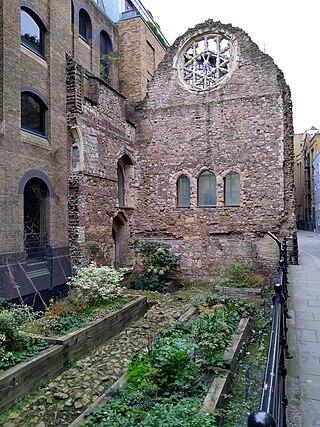
Winchester Palace was a 12th-century bishop's palace that served as the London townhouse of the Bishops of Winchester. It was located in the parish of Southwark in Surrey, on the south bank of the River Thames on what is now Clink Street in the London Borough of Southwark, near St Saviour's Church. Grade II listed remains of the demolished palace survive on the site today, designated a Scheduled Ancient Monument, under the care of English Heritage.

St Anne and St Agnes is a church located at Gresham Street in the City of London, near the Barbican. While St Anne's is an Anglican foundation, from 1966 to 2013 it was let to a congregation of the Lutheran Church in Great Britain.

The Church of Our Lady and Saint Nicholas is the Anglican parish church of Liverpool. The site is said to have been a place of worship since at least the 1250s. The church is situated close to the River Mersey near the Pier Head. The Chapel of St Nicholas was built on the site of St Mary del Quay, which in 1355 was determined to be too small for the growing borough of Liverpool. It is recorded in the National Heritage List for England as a designated Grade II listed building, and is an active parish church in the diocese of Liverpool, the archdeaconry of Liverpool and the deanery of Liverpool North. It is part of the Greater Churches Group. From 1813 to 1868 the church was the tallest building in Liverpool at 174 feet [53 m], but then surpassed by the Welsh Presbyterian Church in Toxteth.
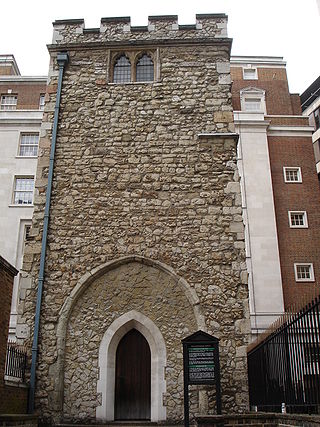
All Hallows Staining was a Church of England church located at the junction of Mark Lane and Dunster Court in the north-eastern corner of Langbourn ward in the City of London, England, close to Fenchurch Street railway station. All that remains of the church is the tower, built around AD 1320 as part of the second church on the site. Use of the grounds around the church is the subject of the Allhallows Staining Church Act 2010.

St Columba's Church is one of the two London congregations of the Church of Scotland. The church building, designed by Sir Edward Maufe, is located in Pont Street, Knightsbridge, near Harrod's department store. It was given Grade II listing by English Heritage in 1988.

St Leonard's, Shoreditch, is the ancient parish church of Shoreditch, often known simply as Shoreditch Church. It is located at the intersection of Shoreditch High Street with Hackney Road, within the London Borough of Hackney in East London. The current building dates from about 1740 and is Grade I listed. The church is mentioned in the line ""When I grow rich", say the bells of Shoreditch" from the nursery rhyme Oranges and Lemons.
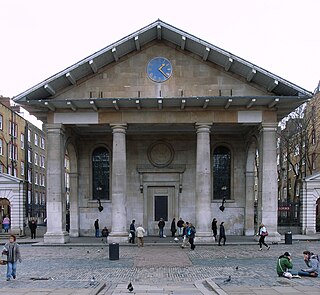
St Paul's Church is a Church of England parish church located in Bedford Street, Covent Garden, central London. It was designed by Inigo Jones as part of a commission for the 4th Earl of Bedford in 1631 to create "houses and buildings fit for the habitations of Gentlemen and men of ability". As well as being the parish church of Covent Garden, the church has gained the nickname of "the actors' church" by a long association with the theatre community.

St Mary Magdalene Church is one of Hope Church Islington's places of worship, an Anglican church on Holloway Road in north London dedicated to Jesus' companion Mary Magdalene. It is located in St Mary Magdalene Gardens opposite Islington Central Library. St Mary Magdalene is part of the Parish of Hope Church Islington. In 2013 its sister church St David's on Westbourne road was reopened so St Mary Magdalene now functions as one of two worship sites of the Parish, with a single leadership and a staff team. The early 19th century building accommodates the activities of the church congregation, including church services, a winter night shelter, 'Mini Mags' – a toddlers group, and provides spaces to other users. Baptisms and confirmations, marriages and funerals are regularly held here. The building and its iron railings are both Grade II* listed structures, having first been listed in 1954.
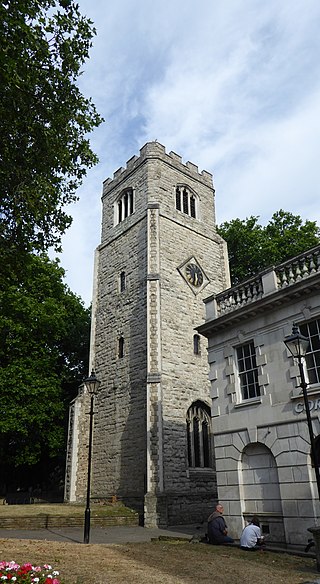
St Augustine's Tower stands in St John's Church Gardens, in central Hackney, in the London Borough of Hackney, just off the southern end of the Narrow Way. It is all that remains of the early 16th-century parish church of Hackney of St Augustine, which replaced the 13th-century medieval church founded by the Knights of St John. The Tower comprises four stages beneath a restored parapet with diagonal buttressing. A fine working 16th-century turret clock has remained on the third floor of the Tower since at least 1608. The Tower and contents are Grade I listed.

Old High St Stephen's Church is a parish church of the Church of Scotland in Inverness, the capital city of the Highlands of Scotland. The congregation was formed on 30 October 2003 by a union of the congregations of Inverness Old High (57.4801°N 4.2289°W) and Inverness St Stephen's (57.4730°N 4.2186°W). Unusually in a union of Church of Scotland congregations, both buildings were retained for worship. In January 2022, regular worship ended at Old High. Since then, the Sunday service takes place at St Stephen's Church at 10:30am

Downing Place United Reformed Church, Cambridge is a church in Cambridge, England, that is part of the United Reformed Church. It was formed in 2018 in a merger between St Columba's Church, Cambridge, and Emmanuel Church, Cambridge. The church occupies the former St Columba's building in Downing Place, which is close to a site occupied by Emmanuel's congregation before 1874.

St Ann Blackfriars was a church in the City of London, in what is now Ireland Yard in the ward of Farringdon Within. The church began as a medieval parish chapel, dedicated to St Ann, within the church of the Dominicans. The new parish church was established in the 16th century to serve the inhabitants of the precincts of the former Dominican monastery, following its dissolution under King Henry VIII. It was near the Blackfriars Theatre, a fact which displeased its congregation. It was destroyed in the Great Fire of London of 1666.

St Paul's Church, Salisbury, England, is the Church of England parish church for Fisherton Anger, serving part of the northern suburbs of the city. It was consecrated in 1853 and lies north-west of the city centre, near the railway station. The congregation is affiliated to the Evangelical Alliance. The church is a Grade II listed building.

St Edmund's Church is the Roman Catholic parish church of Godalming, a town in the English county of Surrey. It was built in 1906 to the design of Frederick Walters and is a Grade II listed building. The church stands on a "dramatic hillside site" on the corner of Croft Road just off Flambard Way close to the centre of the town.

Godalming Friends Meeting House is a Friends meeting house in the ancient town of Godalming in the English county of Surrey. One of many Nonconformist places of worship in the town, it dates from 1748 but houses a congregation whose roots go back nearly a century earlier. Decline set in during the 19th century and the meeting house passed out of Quaker use for nearly 60 years, but in 1926 the cause was reactivated and since then an unbroken history of Quaker worship has been maintained. Many improvements were carried out in the 20th century to the simple brick-built meeting house, which is Grade II-listed in view of its architectural and historical importance.

St George's Church is an Anglican church of modern design in the Parish of Norton in Letchworth Garden City in Hertfordshire. Opening in 1964 and arrow-shaped with a 120-foot concrete spire, the congregation are seated in a semi-circle facing the altar. The church building is in the style of the Liturgical Movement following World War II. It was Grade II listed in 2015 for "its striking architectural form, expressed through a diverse range of materials to provide an innovative building of real quality both in composition and detailing."

The Highland Church was a Gaelic-speaking congregation of the Church of Scotland, based in Tollcross, Edinburgh. Formed by the union of St Oran's Church and St Columba's Gaelic Church in 1948, the congregation continued united with Tolbooth St John's in 1956.
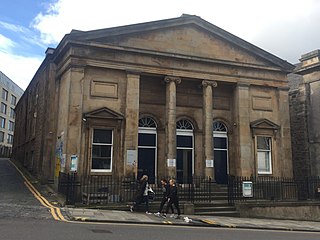
St Oran's Church was a Gaelic-speaking congregation of the Church of Scotland in Edinburgh. Originating in the early 18th-century, the congregation continued until 1948, latterly meeting at Broughton Street.
51°30′48″N0°7′16″W / 51.51333°N 0.12111°W ![]() Media related to Crown Court Church at Wikimedia Commons
Media related to Crown Court Church at Wikimedia Commons